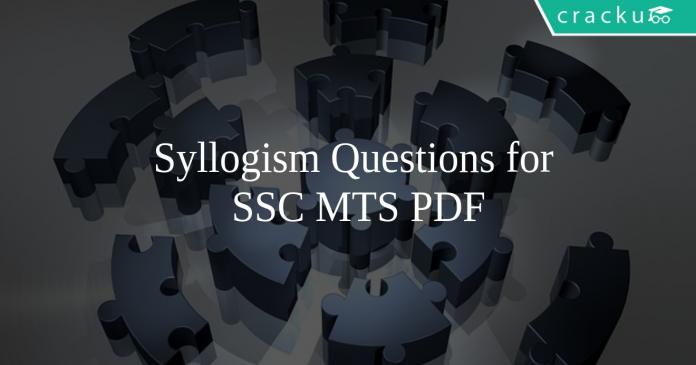Syllogism Questions for SSC MTS PDF
SSC MTS Syllogism Questions download PDF based on previous year question paper of SSC exams. 20 Very important Syllogism Questions for SSC MTS Exam.
Download syllogism questions for ssc mts PDF
Take a free mock test for SSC MTS
Download SSC MTS Previous Papers
Question 1: In the following question, two statements are given each followed by two conclusions I and II. You have to consider the statements to be true even if they seem to be at variance from commonly known facts. You have to decide which of the given conclusions, if any, follows from the given statements.
Statements:
(I) Some polynomials are linear equations.
(II) Some linear equations are quadratic.
Conclusion:
(I) Polynomials are quadratic.
(II) Linear equations are quadratic.
a) Conclusion I follows
b) Conclusion II follows
c) Neither I nor II follows
d) Both I and II follows
Question 2: In the following question, two statements are given each followed by two conclusions I and II. You have to consider the statements to be true even if they seem to be at variance from commonly known facts. You have to decide which of the given conclusions, if any, follows from the given statements.
Statements:
(I) All paper are files.
(II) Some files are pens.
Conclusion:
(I) No paper is a pen.
(II) Some papers are pens.
a) Conclusion I follows
b) Conclusion II follows
c) Neither I nor II follows
d) Both I and II follows
Question 3: In the following question, two statements are given each followed by two conclusions I and II. You have to consider the statement to be true even if they seem to be at variance from commonly known facts. You have to decide which of the given conclusions, if any, follows from the given statements.
Statements:
(I) All birds are trees.
(II) Some trees are hens.
Conclusion:
(I) Some birds are hens.
(II) Some hens are trees.
a) Conclusion I follows
b) Conclusion II follows
c) Neither I nor II follows
d) Both I and II follows
Question 4: In the following question, two statements are given each followed by two conclusions I and II. You have to consider the statement to be true even if they seem to be at variance from commonly known facts. You have to decide which of the given conclusions, if any, follows from the given statements.
Statement:
(I) All horses are bullocks.
(II) All bullocks are goats.
Conclusions:
(I) All horses are goats.
(II) All goats are horses.
a) Conclusion I follows
b) Conclusion II follows
c) Neither I nor II follows
d) Both I and II follows
Question 5: In the following question, two statements are given each followed by two conclusions I and II. You have to consider the statements to be true even if they seem to be at variance from commonly known facts. You have to decide which of the given conclusions, if any, follows from the given statements.
Statement:
(I) Some authors are teachers.
(II) No teacher is a lady.
Conclusions:
(I) Some teachers are not ladies.
(II) Some authors are not teachers.
a) Conclusion I follows
b) Conclusion II follows
c) Neither I nor II follows
d) Both I and II follows
SSC MTS Study Material (FREE Tests)
Question 6: In the following question, two statements are given each followed by two conclusions I and II. You have to consider the statements to be true even if they seem to be at variance from commonly known facts. You have to decide which of the given conclusions, if any, follows from the given statements.
Statement:
(I) Men are sinners.
(II) Saints are men.
Conclusions:
(I) Saints are sinners.
(II) Sinners are saints.
a) Conclusion I follows
b) Conclusion II follows
c) Neither I nor II follows
d) Both I and II follows
Question 7: In the following question, two statements are given each followed by two conclusions I and II. You have to consider the statements to be true even if they seem to be at variance from commonly known facts. You have to decide which of the given conclusions, if any, follows from the given statements.
Statements:
(I) All fans are cups.
(II) All cups are pillows.
Conclusion:
(I) All fans are pillows.
(II) All pillows are fans.
a) Conclusion I follows
b) Conclusion II follows
c) Neither I nor II follows
d) Both I and II follows
Question 8: In the following question, two statements are given each followed by two conclusions I and II. You have to consider the statements to be true even if they seem to be at variance from commonly known facts. You have to decide which of the given conclusions, if any, follows from the given statements.
Statements :
(I) Some camels are ships.
(II) No ship is a boat.
Conclusion :
(I) Some ships are camels.
(II) Some camels are not boats.
a) Conclusion I follows
b) Conclusion II follows
c) Neither I nor II follows
d) Both I and II follows
Question 9: In the following question, two statements are given each followed by two conclusions I and II. You have to consider the statements to be true even if they seem to be at variance from commonly known facts. You have to decide which of the given conclusions, if any, follows from the given statements.
Statements:
(I) Most crops are machines.
(II) Some machines are fools.
Conclusion:
(I) Some fools are machines.
(II) Some crops are fools.
a) Conclusion I follows
b) Conclusion II follows
c) Neither I nor II follows
d) Both I and II follows
Question 10: In the following question, two statements are given each followed by two conclusions I and II. You have to consider the statements to be true even if they seem to be at variance from commonly known facts. You have to decide which of the given conclusions, if any, follows from the given statements.
Statements:
(I) All dogs are bullocks.
(II) All bullocks are goats.
Conclusion:
(I) All dogs are goats.
(II) All goats are dogs.
a) Conclusion I follows
b) Conclusion II follows
c) Neither I nor II follows
d) Both I and II follows
Question 11: In the following question, two statements are given each followed by two conclusions I and II. You have to consider the statements to be true even if they seem to be at variance from commonly known facts. You have to decide which of the given conclusions, if any, follows from the given statements.
Statements:
(I) All pilots are brave men.
(II) All astronauts are pilots.
Conclusion:
(I) All astronauts are brave men.
(II) Some pilots are astronauts.
a) Conclusion I follows
b) Conclusion II follows
c) Neither I nor II follows
d) Both I and II follows
FREE SSC MATERIAL – 18000 FREE QUESTIONS
DOWNLOAD APP TO ACESSES DIRECTLY ON MOBILE
Answers & Solutions:
1) Answer (C)
The venn diagram for above statements is :

Conclusion:
(I) Polynomials are quadratic = false
(II) Linear equations are quadratic = false
Thus, neither I nor II follows
=> Ans – (C)
2) Answer (C)
The venn diagram for above statements is :

Conclusion:
(I) No paper is a pen = may or may not be true
(II) Some papers are pens = may or may not be true
Thus, neither I nor II follows
=> Ans – (C)
3) Answer (B)
The venn diagram for above statements is :
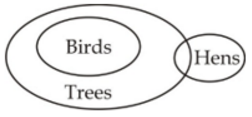
Conclusion:
(I) Some birds are hens = false
(II) Some hens are trees = true
Thus, only conclusion II follows
=> Ans – (B)
4) Answer (A)
The venn diagram for above statements is :
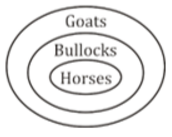
Conclusions:
(I) All horses are goats = true
(II) All goats are horses = false
Thus, only conclusion I follows
=> Ans – (A)
5) Answer (A)
The venn diagram for above statements is :

Conclusions:
(I) Some teachers are not ladies = true
(II) Some authors are not teachers = false
Thus, only conclusion I follows.
=> Ans – (A)
6) Answer (A)
The venn diagram for above statements is :
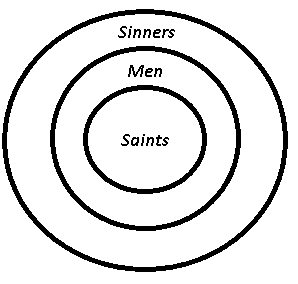
Conclusions:
(I) Saints are sinners = true
(II) Sinners are saints = false
Thus, only conclusion I follows
=> Ans – (A)
7) Answer (A)
The venn diagram for above statements is :

Conclusion:
(I) All fans are pillows = true
(II) All pillows are fans = false
Thus, only conclusion I follows
=> Ans – (A)
8) Answer (D)
The venn diagram for above statements is :

Conclusion :
(I) Some ships are camels = true
(II) Some camels are not boats = true
Thus, both I and II follows
=> Ans – (D)
9) Answer (A)
The venn diagram for above statements is :
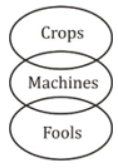
Conclusion:
(I) Some fools are machines = true
(II) Some crops are fools = false
Thus, only conclusion I follows
=> Ans – (A)
10) Answer (A)
The venn diagram for above statements is :
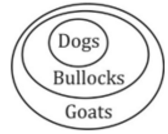
Conclusion:
(I) All dogs are goats = true
(II) All goats are dogs = false
Thus, only conclusion I follows
=> Ans – (A)
11) Answer (D)
The venn diagram for above statements is :

Conclusion:
(I) All astronauts are brave men = true
(II) Some pilots are astronauts = true
Thus, both I and II follows
=> Ans – (D)


